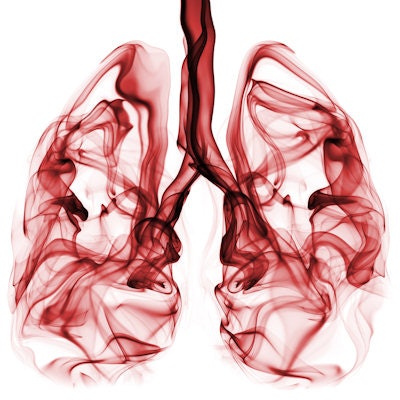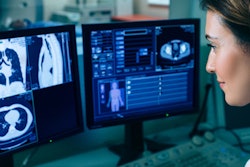
Integrating risk-prediction models into eligibility criteria for CT lung cancer screening could prevent up to 24% more cancer deaths than using guidelines from the U.S. Preventive Services Task Force (USPSTF), with no difference in the number of smokers screened, according to a report published June 3 in the Annals of Internal Medicine.
The researchers from the U.S. National Cancer Institute examined the potential advantages of using various risk-prediction models instead of existing methods to identify which individuals would benefit most from CT lung screening. They found that setting relatively high risk thresholds for two distinct risk models could prevent more lung cancer deaths with fewer false-positive exams than current USPSTF guidelines (Ann Intern Med, June 3, 2019).
The potential of these risk models to improve overall screening efficiency may help motivate the USPSTF to incorporate such models in the forthcoming update to its guidance on CT lung cancer screening, first author Rebecca Landy, PhD, told AuntMinnie.com.
Due for an update
The current USPSTF guidance on CT lung cancer screening recommends screening for current or former smokers 55 to 80 years old who have a smoking history of at least 30 pack-years. Since the release of those guidelines in 2013, a number of studies have shown that lung cancer risk-prediction models could be a more effective way to determine who needs screening, compared with the existing one-size-fits-all guidelines.
With an update to its guidance on CT lung screening on the horizon, the USPSTF confirmed in its recent draft research plan that it is considering integrating externally validated risk models. One of the key questions presented in the task force's research plan was whether or not risk-prediction models, which typically factor in a wide range of clinical and demographic variables, would more accurately identify individuals at high risk of lung cancer death than current USPSTF eligibility criteria.
"The USPSTF is considering recommending the use of lung cancer risk models to determine eligibility for lung cancer screening, and the National Comprehensive Cancer Network (NCCN) guidelines already recommend lung cancer screening for ever-smokers with a six-year lung cancer risk exceeding 1.3%, as based on the Prostate, Lung, Colorectal, and Ovarian (PLCO) Cancer Screening Trial Model 2012 (M2012) risk model," Landy said. "However, the implications of the NCCN threshold, and other proposed thresholds, have not been evaluated with contemporary U.S. data."
In the current research report, Landy and colleagues explored potential benefits that several risk-prediction models with different risk thresholds could offer screening:
- ≥ 1.3%-NCCN: The NCCN guidelines cover current and former smokers with a six-year lung cancer risk of at least 1.3% based on the PLCO(M2012) risk model.
- ≥ 1.51%-PLCO(M2012): The criteria include individuals with a six-year lung cancer risk of 1.51% or higher based on PLCO(M2012).
- ≥ 1.2%-LCDRAT: The criteria include individuals with a five-year risk of lung cancer mortality of at least 1.2% following the Lung Cancer Death Risk Assessment Tool (LCDRAT).
The group applied each of these individualized screening criteria to data from the 2005 and 2015 National Health Interview Surveys.
More efficient
Upon examining projections of the three distinct screening criteria, the researchers found that using any one of them would have increased the total number of high-risk smokers identified -- by 57% for ≥ 1.3%-NCCN, by 41% for ≥ 1.51%-PLCO(M2012), and by 12% for ≥ 1.2%-LCDRAT -- as well as the number of lung cancer deaths prevented, compared with the USPSTF guidelines. However, only the ≥ 1.2%-LCDRAT criteria improved the overall efficiency of CT lung screening.
| Projected performance of different eligibility criteria for CT lung cancer screening | ||||
| USPSTF guidelines | ≥ 1.3%-NCCN | ≥ 1.51%-PLCO(M2012) | ≥ 1.2%-LCDRAT | |
| No. of ever-smokers identified | 8 million | 12.6 million | 11.3 million | 9 million |
| Lung cancer deaths prevented | 41,298 | 56,528 | 54,456 | 53,732 |
| No. needed to screen to prevent one death | 194 | 222 | 207 | 168 |
| False-positive exams per prevented death | 133 | 150 | 141 | 119 |
Landy and colleagues subsequently recalibrated the risk thresholds for the two risk-prediction models in an effort to further improve screening efficiency. They increased the lung cancer risk threshold to at least 2.19% based on the PLCO(M2012) risk model and at least 1.33% based on the LCDRAT risk model.
Increasing the risk thresholds in this way would have resulted in the same total number of individuals undergoing screening in 2015 using either one of the risk-prediction models or the USPSTF guidelines -- effectively allowing for a direct comparison of the screening efficiency of the models to that of the USPSTF guidelines, Landy said.
The researchers found that using the elevated risk thresholds for the risk-prediction models would have identified the same number of eligible ever-smokers as current USPSTF guidelines but for a cohort with a much higher risk of lung cancer.
Quality control
As a result, the 2.19%-PLCO(M2012) risk threshold was projected to prevent 14% more lung cancer deaths than the USPSTF guidelines. Better still, the 1.33%-LCDRAT risk threshold was projected to prevent 24% more lung cancer deaths.
With elevated risk thresholds, the risk models were also much more efficient than the USPSTF guidelines, reducing the number of screening exams required to prevent one death and the number of false-positive exams per prevented death.
| Projected performance of different eligibility criteria for CT lung cancer screening | |||
| USPSTF guidelines | ≥ 2.19%-PLCO(M2012) | ≥ 1.33%-LCDRAT | |
| No. of ever-smokers identified | 8 million | 8 million | 8 million |
| Lung cancer deaths prevented | 41,298 | 47,401 | 51,019 |
| No. needed to screen to prevent one death | 194 | 169 | 156 |
| False-positive exams per prevented death | 133 | 119 | 112 |
The lung cancer risk threshold of 1.3% recommended in the NCCN guidelines was proposed based on data from 1993 to 2001, a period during which heavy smoking was much more frequent in the U.S. than it was in 2015, according to the authors. An increased risk threshold of 2.19% may better reflect current smoking trends.
Shifts in demographic characteristics, including smoking habits, may warrant the need for continuous adjustments in eligibility criteria for CT lung screening, Landy noted.
"Our findings indicate the importance of regularly evaluating risk thresholds and models for CT lung screening guidelines to ensure they perform as expected," she said.




















